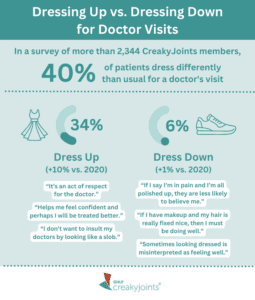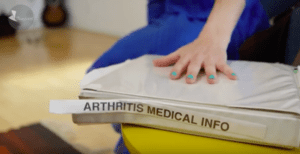First impressions matter, as anyone who’s ever been on a job interview or first date knows all too well. They also play a key role in health care settings. We don’t always want to think about it, but the truth is that it is human nature for providers to form snap judgments about patients based on how they look or act during visits.
This is a lesson that Nicole Dalton — who’s been living with systemic-onset juvenile idiopathic arthritis (SJIA) for nearly 30 years — learned the hard way, after enduring too many doctor visits where she felt like her symptoms were dismissed because her appearance didn’t match the grave seriousness of her condition.
Aside from deformities in her hands that developed from the ravages of decades of inflammation, Nicole’s arthritis is largely invisible. And as an actress and comedian based in Los Angeles, appearing presentable and attractive is basically part of Nicole’s job and way of life.
It never occurred to her that how she looked during doctor visits could be sabotaging her medical care and treatment.
One day about six years ago, Nicole realized that her doctors were not listening to her, nor taking her increasingly life-threatening symptoms seriously. Her friend, also living with an invisible condition, enlightened her with this simple advice:
“She told me, ‘You have to dress to match how you physically feel,’” Nicole says.
The change in doctor-patient communication that Nicole experienced was powerful and immediate. “I noticed a huge difference in the ways doctors listened to and treated me,” she says. “Of course, not every doctor is like this, but I find that many respond to how you look. This hack has helped me get the bloodwork, appointments, medications, and — most importantly — the care I desperately knew I needed.”

The Concept of ‘Dress to Depress’
This revelation is what inspired Nicole to create and produce a digital campaign called Dress to Depress: An Invisible Illness Guide to Getting Ready for a Doctor’s Appointment. Working with CreakyJoints and a team of writers, producers, and actors who each lives with or advocates for invisible chronic illnesses, such as systemic-onset juvenile idiopathic arthritis, Crohn’s disease, multiple sclerosis, and gastroparesis, Nicole and her cast and crew wanted to creatively demonstrate the challenges around preparing for doctor visits when you have a chronic illness.
In the video, Grace, a fictional rheumatoid arthritis patient, is about to leave her house for a visit with the rheumatologist. She’s wincing in pain as she tries to put on her shoes, but she’s wearing a fashionable blue dress, her hair is curled, and she’s wearing lipstick. In other words, she looks great, and you’d never know just by looking at her that she’s suffering.
As she’s about to walk out the door, she’s stopped in her tracks by the Sad Squad, a “makeunder” team that helps her dress down — rather than dress up. They inform her that looking too good may prevent the physician really understanding how much pain she’s been in recently.
“Honey, you have an invisible illness,” the character Coco, played by Nicole, tells Grace. “But we are here to make it visible.” The Sad Squad then proceeds to help Grace find a shabbier outfit and ensure her makeup doesn’t overly glamorize her.
“You look like you just biked to Moon Juice for your daily double shot of wheat grass and CBD when in reality you’ve been bedridden with a flare-up that lasted two days, choking down painkillers and buried under ice packs,” says the character Chris, the Sad Squad’s wardrobe expert. “We need to see that reflected in your outfit.”
The squad also helps her organize her medical records, familiarize herself with crucial doctor’s office staff, and ensures she attends the visit with a friend who can take notes and advocate on her behalf.
Modeled after traditional makeover shows such as Queer Eye, the video is a parody whose storylines hit very close to home for Nicole and other chronically ill patients living with invisible illnesses.


Dressing Up vs. Dressing Down: What’s Better?
For many CreakyJoints patients, the notion of “dressing down” for a doctor visit is counterintuitive, or even shocking.
We surveyed our community about this issue and 60 percent (of 2,344 survey respondents) said they don’t dress any differently than they usually do for a doctor visit, 34 percent said they dress up, and only 6 percent reported that they dress down.
Among those who said they dress up for the doctor, many said they did so because they thought it helped them command respect.
“I feel I’m taken more seriously if I look ‘professional,’” one patient shared. “If I look like a disheveled hot mess, I feel that doctors treat me like a victim, like I am less informed and intelligent. If I look put together, they take me more seriously and it’s more of a partnership.”
Another echoed a similar sentiment: “When I look better, my doctor tends to tread me as an equal or as a partner. We have detailed conversations about treatments and options. When I look unkempt, he tells me to take prednisone and boots me out of the office.”
Others said they dressed up because it helped them feel more confident or because they want to make a good impression.
On the other hand, those who said they dress down shared some of the same realizations as Nicole.
“I leave my makeup off at a rheumatology appointment because I don’t want them to think I am well when I am not,” one patient shared.
Other responses included: “If I say I’m in pain and I’m all polished up, they are less likely to believe me” and “Sometimes looking dressed is misinterpreted as feeling well and symptoms are ignored or are seen as less than they are. Sad but true. One male doctor actually said ‘well, you could do your hair; can’t be that bad.”
So, Does Your Appearance Really Matter?
For her part, Nicole is not trying to mandate that everyone look like garbage when they go to the doctor.
“Some patients may feel like they’re getting optimal care regardless of how they look, or that dressing up works for them, and that’s great,” she says. “But I wonder how many patients may not be aware of this potential bias regarding people living with invisible illnesses and have even considered the idea of dressing to match how they physically feel.”
It makes sense, she says, that chronically ill people don’t want to look sick. Improving your appearance and looking put-together can give you confidence and control, which are things that chronic illness routinely robs you of. But for some, looking — and acting — too good may backfire. And patients need to be aware of this phenomenon, Nicole says.
“I’m a naturally vivacious person who happens to inhabit a body with physical limitations that do not match my personality,” says Nicole. “But I’ve learned that when you’re used to living at an 8 on the pain scale, remaining constantly upbeat will not always get you far with some doctors.”
In our survey, patients said the way they appear and act during doctor visits — such as whether they appeared in pain vs. not in pain, or clear-headed vs. foggy — did affect some aspects of the care they received. Patients said that when they didn’t seem to be doing well, their providers asked more specific questions about how they were feeling and their symptoms and spent more time with them than usual.

Getting Organized for Appointments
Another part of Nicole’s mission with Dress to Depress is to encourage people to maximize their doctor visits. “As invisible illness patients, we have to prepare ahead of time to maximize our doctor visits and get what we need to live our fullest, healthiest lives,” she says.
In our survey, 36 percent of our respondents said they visit their provider every two to three months. While that may sound like a lot (say, compared to people who tend to go to the doctor just for an annual physical and sick visits as needed) anyone with chronic illness knows you have to pack a lot of information, Q&A, and listening into those visits.
You can read more here about our patient community’s best tips and advice for getting ready for doctor or visits.
A Final Word from CreakyJoints
When it comes to how you dress for doctor’s visits, there are no clear right or wrong approaches. While there are studies that show that how doctors dress can affect patient perceptions of authority and trustworthiness (ex: white coats vs. no white coats; surgical scrubs vs. regular office clothes) there’s no research, to our knowledge, on how patient appearances affect doctors’ impressions. That’s why we undertook this research initiative to find out, and we’re still learning and we want to hear your thoughts on this issue.
Check out the cast members of Dress to Depress and follow them on Instagram:
Track Your Symptoms with PatientSpot
Join CreakyJoints’ patient-centered research registry and track symptoms like fatigue and pain. Learn more and sign up here.





